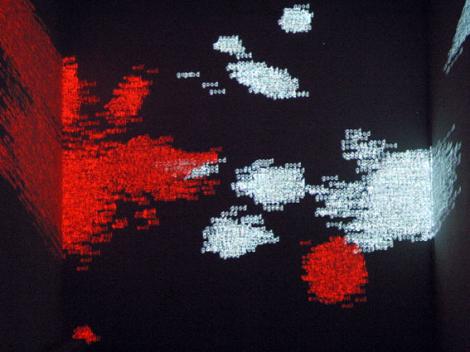Charles Sandison
dal 16/5/2002 al 20/7/2002
Segnalato da
16/5/2002
Charles Sandison
Galerie Frank Elbaz, Paris
Good and Evil. This work is based around two words and their relationship. The work of Sandison gives us a hint of what Peter Weibel has called post-ontological art. That means an existence of a kind of immaterial creation possessing human properties such as intelligence, life and conscience - all artificial -, yet without any material existence. We would not be able to register their presence, they would represent a subject lacking ontological status.

Good and Evil
This work is based around two words and their relationship. Both wordsposses the same attributes and have exactly the same goal. They try to colonies the space at the expense of the other word. The drive to occupyall the given space is motivated by the desire to eliminate their opposite.Equally, the desire to eliminate the other requires them to colonies all available space. Thus the will to exist is defined by struggle and a conflict of opposites.
Life is the motor that drives itself relentlessly forward; I see this system as a valid reality in itself. The words suggest an opposition of type, reflected in the timeless idea of the struggle between good and evil. This contrast is also reflected through the coloring of the words, the evil words are bright red and the white words are the pure white of projected light.
The words are animated using similar genetic codes as found in mmicroorganisms such as bacteria or cancerous cells. As the words move in opposition to each other they organize themselves into columns of attackand lines of defense. When the words collide there is a 50/50 chance which word will be eliminated. As the white and red flow into each other they flicker, producing shades of pink. There can be as many as 40.000 words moving in clusters and formations as the battles rage. The viewer is placedat the centre of the work, the room becomes a vessel, and thebody is turned in on itself.
The speed at which the words move is slow yet fluid, suggesting the quality of a dense liquid like oil paint. I am interested by the religious space of the church as represented in the motifs of the genre of religious painting. Like the fantastic canvas of Breughel - 'Triumph of Death'. The words, as they move, are like broad-brush strokes, spreading out into the darkness of the room. I enjoy how painters have used biblical material as a source to explore dramatic contrasts. My technique is to paint with light, time, and elemental characters.
Charles Sandison born in Scotland, works and lives in Finland.
Galerie Frank,
14 rue des Pyramides 75001
Paris



